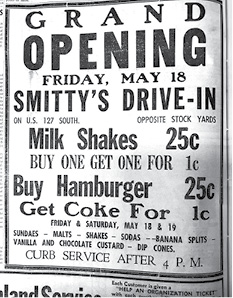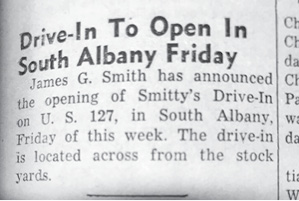In Albany there was only one Smitty

By David Cross
You generally had to wait until five o’clock to order from your car. Except on Sundays.
That’s when the carhops would go to work. Sometimes the evening started off slow, and sometimes with a bang. There was no guarantee of a parking spot after 6:00 p.m. on weekends. Shrimp boxes, oyster boxes, tater tots, tenderloins—a steady flow came out of the kitchen and into the parking lot.
The carhops were not only the purveyors of food at the local drive in, but the purveyors of gossip and information, and as a private messaging service from car to car. And they were the principal means of delivery to the customers of something that has nearly passed from the landscape of America—the drive-in restaurant.
Upon the advent of the automobile, drive-in restaurants, and carhops, were not far behind. They didn’t hit Albany until the 1950s. Some drive-ins had tables inside, and some didn’t. Harley Cross may have actually had the first local true drive-in, the Parkette on the Tennessee Road just north of what is now City Mart. However, when Harley’s daughters got married, he lost his labor force and sold out and it later became a laundromat for many years, and finally Ferguson’s Fruit Market.
J.O. Brown, the large and affable entrepreneur of South Albany, was not far behind. He and his wife, Olene, started the Highway 35 Drive-In on the outskirts of town at what is now The Garden Spot. They had to change the name to 127 Drive-In when the federal number went on the road in 1960. It became Brown’s Foodliner in the mid-1960s.
There were other drive-ins including the J & K which started in the mid-sixties in the same building where Lee’s Famous Recipe is now located. The J & K had a successful run, with indoor tables as well as carhop service. For a few years there was the Twin Twirl, located in Duvall Valley at the junction of KY 415 and KY 696, operated by Betty Daily’s mother, Maxine Massengale. There was also Graham’s Town & Country drive-in at the location that became Lowhorn’s Steakhouse on North 127, which evolved into the School Board offices.
But the king of the drive-in restauranteurs was undoubtedly James Granville “Smitty” Smith, who passed last week at age 84. Smitty was raised in Sugar Valley and left home in the early 1950s to work in the Cleveland area. He worked his way up to the position of store manager at Kroger, and he married and started a family. However, he and his wife Shelva agreed that their future was on the Tennessee Road in South Albany.
In May 1962 and Shelva opened Smitty’s Drive-In, where hamburgers were just a quarter and carhop service was available (initially it began at 4:00 p.m., according to the opening week ad in the Clinton County News).
Smitty started out with a window that you ordered from and some picnic tables under shelter. He later added on an inside dining area (with an area in the back for pinball machines—Smitty always had good pinball machines) and he and Shelva, with the help of Smitty’s mother and aunt and, of course, the Young sisters—Ruby, Gertie, Clara and Sue—dished out an incredible number of burgers, tenderloins, and fries over the next 38 years.
It was said that Smitty was Uncle Charlie’s (the tenderloin wholesaler) best customer for many years. We figure if Smitty sold 100 orders of french fries a day ( a conservative estimate) for 38 years, averaging 340 days per year (he closed a week during Christmas and a week in the summer, as well as closing early on Sunday afternoon), that adds up to 1.3 million orders of fries.
We have been told that Larry Flowers was Smitty’s first carhop, but he was not the most famous. That honor might well go to Bobby Wayne (Bimbo) Claborn, who patrolled the parking lot for several years in the 1960s. There were countless others, but some of the more legendary were Michael Cummings (whose mom worked inside), Morgan Dalton, Glenn Russell and the acrobatic, pencil-thin “Pennywinkle” (Jimmy Pennycuff). It seemed like the carhops knew everyone, and everything.
In those days from the 1960s to the 1980s, it seemed like everyone hung out on the south end of town—when parents asked their kids where they were going, often the reply was “Circle Smitty’s”. It was a continuous line of traffic on Friday and Saturday nights from the J & K to Smitty’s — back and forth, and back and forth.
Local musician Mark Conner even wrote and recorded a song about it. Tires were squealed, beer runs made, and friendships—and enemies—were created. Courtships began with a wave—and then maybe actually backing in next to that someone who finally waved back. A lot happened at Smitty’s.
Now it looks like no one just “hangs out” in town any more. The messages that used to be carried by carhops are sent by text. Nearly every restaurant has a drive-in window, which is what led to the demise of carhops and the decline of drive-in restaurants. But all of us from that generation have memories of hanging out at Smitty’s. We’d wager that something memorable happened to you at Smitty’s, or at least started there.
There’s thousands of people nicknamed “Smitty” in America. However, in Albany there was only one. Here’s to our friend Smitty—businessman, long-time City Councilman, and progressive citizen of our town—and to the memories that he helped us all make.

An advertisement, above, and a short front page reminder appeared in the Thursday, May 17,1962 edition of the Clinton County News, announcing the opening of Smitty’s Drive In on U.S. 127.
At the time, the new restaurant was located with the Albany Stockyards being directly across the street, providing a mixed aroma of Smitty’s burgers being grilled and a parking lot full of beef cattle being sold on Wednesdays, the traditional sale day for the stockyards.
